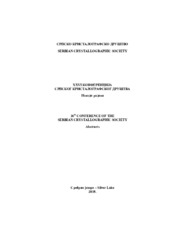| dc.description.abstract | BaSnO3 (BSO) belongs to the perovskite-type oxides with a cubic crystal structure. It
exhibits interesting electrical, optical and photocatalytic properties. BSO has a potential
application as transparent conductor, gas sensor, photocatalyst or dielectric capacitor. It is
an insulating material with wide band gap (Eg = 3.1–3.4 eV), but its electrical properties
can be adjusted by doping with aliovalent cations.
In this work, we investigated the influence of antimony (Sb3+), as a dopant, on crystal
structure, microstructural and electrical properties of BSO ceramics. Stoichiometric
mixture of powders BaCO3, SnO2 and Sb2O3 was mechanochemically activated in a
planetary ball mill and afterwards calcined at 900 ºC for 4 h. As-prepared powders were
sintered by spark plasma sintering technique (1200 ºC for 5 min) in order to produce
ceramic samples BaSn1-xSbxO3 (x = 0.00, 0.04, 0.06, 0.08 and 0.10). All samples were
characterized using X-ray Diffraction (XRD) analysis, High Resolution Transmission
(HRTEM) and Field Emission Electron Microscopy (FESEM). Electrical conductivity of
BaSn1-xSbxO3 ceramics was determined by measuring of the current-voltage (I–U)
characteristics in different mediums and at different temperatures.
XRD analysis confirmed the existence of cubic BSO, as a dominant phase, and
tetragonal Ba2SnO4, as a secondary phase. FESEM analysis revealed homogenous
microstructure in all samples and noticeable decrease of the grain size in doped samples
compared to BSO. HRTEM micrographs of the undoped sample showed less ordered
microstructure with amorphous phase in the grain boundary region. Doped samples
revealed much higher crystallinity, especially in the grain boundary regions without
presence of defects. Low angle grain boundaries (LAGB) are observed (the angle equals
2.08°) on the HRTEM micrographs of BaSn0.92Sb0.08O3. It was observed that all doped
samples are n-type semiconductors, having linear I–U characteristics up to 150 °C.
Sample BaSn0.92Sb0.08O3 showed the highest conductivity, most likely due to the presence
of the LAGB, which allow easier charge carrier transfer between grains and greater
carrier mobility [1].
[1] Y. Furushima, A. Nakamura, E. Tochigi, Y. Ikuhara, K. Toyoura, K. Matsunaga, J.
Appl. Phys., 120 (2016) 1421071–1421079. | sr |

